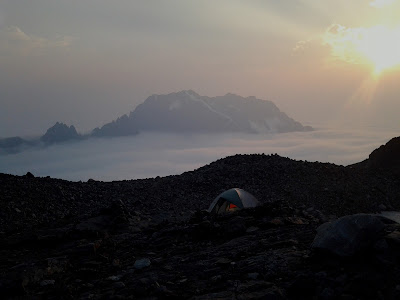 |
| Smokey skies above rolling clouds below my Fall Equinox campsite. |
2012 has been a record year for Wildfires in the US. The total area burned, some of which is still burning, is three times the next largest scorched area within the last ten years. The above-normal fire weather potential of the West occurred as a result of the hot, dry conditions that have persisted. Combined with lightening storms and dried out higher-elevation fuels, wildfires have been sparking up en mass. The increase in the number of wildfires and scorched area is not just an isolated event of 2012. Since 1972 the frequency of wildfires has increased at least four-fold, and the total size of burn areas has increased at least six-fold in the western United States.
| Washington wildfires from space. |
As extreme as the heat wave of Summer 2012 was, it pales in comparison to the record breaking temperatures experienced this Spring. The duration, areal size, and intensity of the high temperature events in March, 2012 are epic, and the event ranks as one of North America's most extraordinary weather events in recorded history. Of these extraordinary weather event the mos extreme were low temperatures beating previous high temperature records for the same date. Never before was there a case where the low temperature for the date beat the previous record high. This happened on several occasions during March, 2012. Marquette's low of 52 beat the previous high of 49. Mt. Washington NH's low of 44 eclipsed the previous high of 43. The low tied the high in several cities in MN and IL. Many of these hot March days also broke the record high temperature for the corresponding date in April. Another unimaginable temperature phenomena of March 2012 was the range at which some of the temperatures were broken. In at least three locations in the country the previous high was broken by over 30 degrees.
Now as fall cools things down we all forget about the hot 2012 and move on with our daily routine. The extreme heat of the Spring and Summer has fallen out of the news cycle and politicians are not considering taking actions that may help slow down or prohibit future extreme climactic anomolies. The Farmers Almanac used to tell us what to expect and how to plan for the weather of the upcoming season. How do we plan for more weather like Spring and Summer of 2012?
No comments:
Post a Comment